Salmon Patty Recipe
This salmon patty recipe is just as flavorful and easy-to-make as you remember! This flexible recipe can use frozen, fresh, or canned salmon, making it a perfect weeknight dinner.
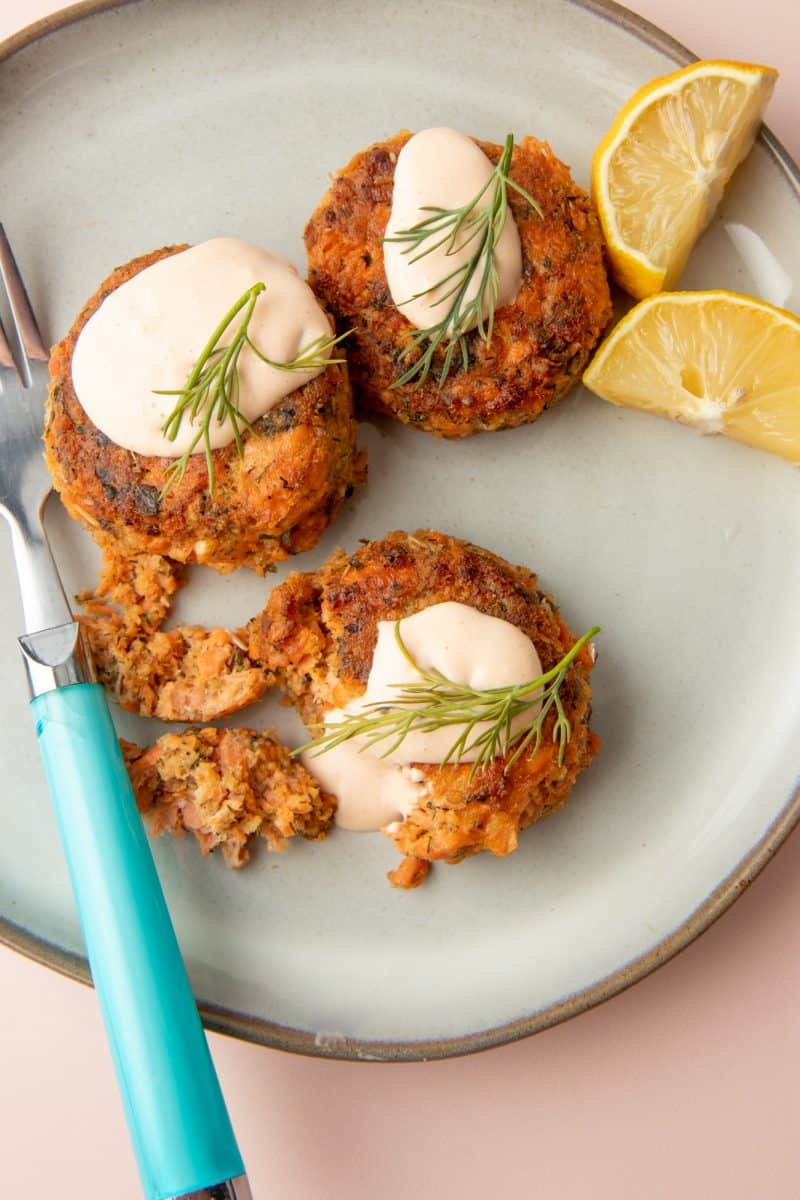
Why You'll Love This Recipe
Salmon patties are weekly staple in our house-meaning I have made literally thousands of salmon patties in my life! And these bad boys turn out perfectly crunchy, flavorful, and tender every single time. Here's why you'll love this recipe:
- You can use fresh, frozen, or canned salmon for this recipe. Although I recommend canned here just because it's more affordable and you can keep it stashed in your pantry for last-minute dinners!
- These patties are a great way to get healthy, nourishing fatty fish into your diet. Even salmon haters love these patties! I make them into small balls for younger kids, and they gobble them up.
- These babies freeze beautifully! I always double my batch when making salmon patties so I can freeze half for an easy low-cook dinner another day.
- This recipe is kitchen-tested for success. I've made this recipe literally thousands of times, so you can trust this will turn out perfectly for you the first time!
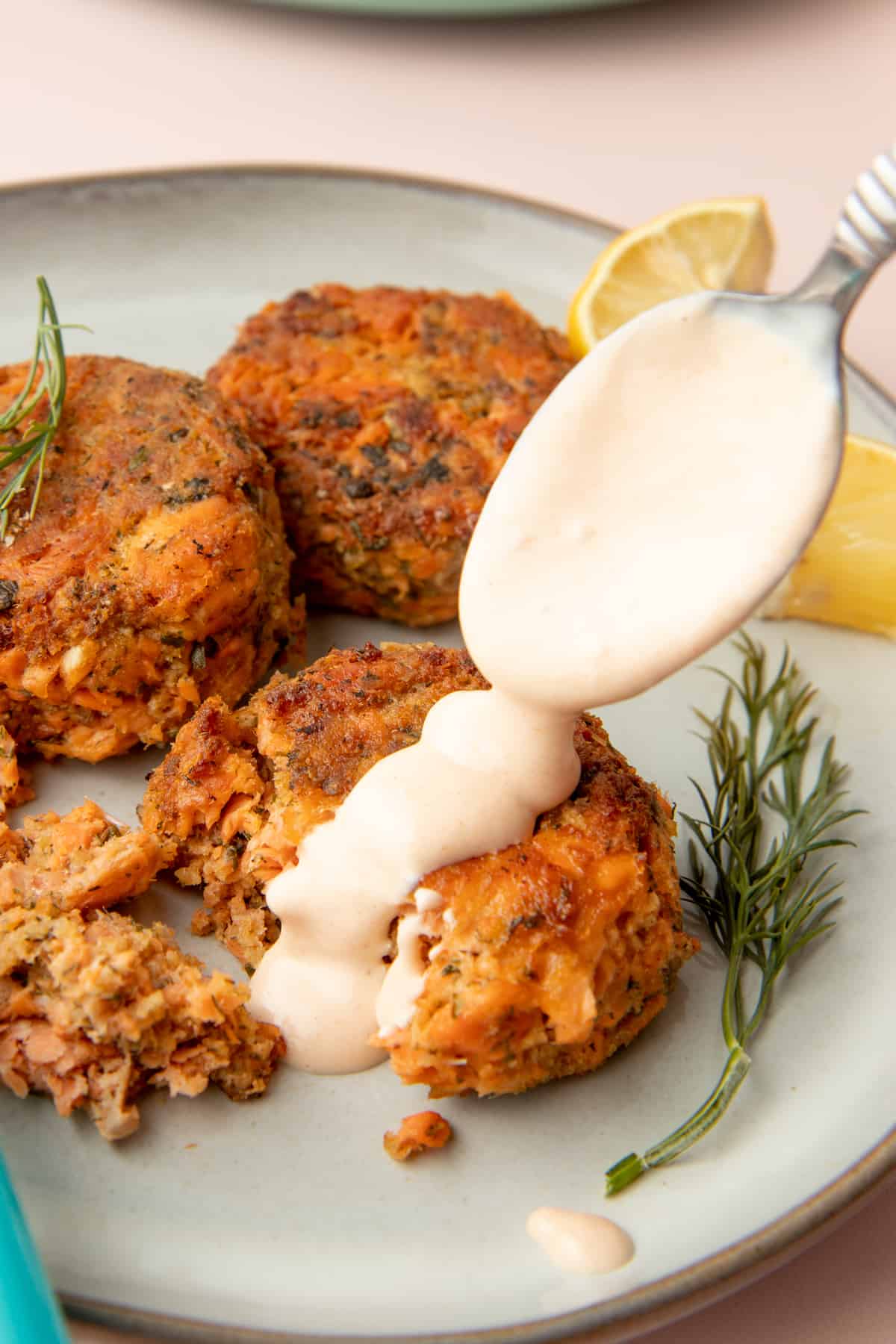
What You'll Need
This is the ultimate pantry recipe. I like to keep everything on hand so can make salmon patties whenever 5pm rolls 'round, and I have no idea what to cook (happens to me too!). Here's what you'll need:
- Salmon: I prefer using canned salmon because it saves some time and money, but if you have fresh or frozen salmon on hand, that works, too!
- Eggs: You can also use a gelatin, flax or chia eggs instead.
- Breadcrumbs: I like panko breadcrumbs because they make the crust get a bit crunchier, but you can use regular, too.
- Dried or fresh dill: Dill and salmon are a match made in heaven! Dried works just as well a fresh here.
- Capers (secret ingredient!): Capers are optional, but they add an amazing briney flavor to the patties that takes them to the next level.
- Garlic and onion powder: I prefer using powders here because I don't want any crunchy bits of uncooked garlic or onion in my salmon patties.
- Salt: Gotta season these babies!
- Oil for frying: I like using avocado oil for pan frying because of it's high smoke point and neutral flavor, but coconut oil and olive oil would also do the trick.
Watch The Video
How to Make Salmon Patties
Follow along with my numbered instructions and step-by-step photos to see exactly how I cook these salmon patties in my home kitchen. Here's how to do it:
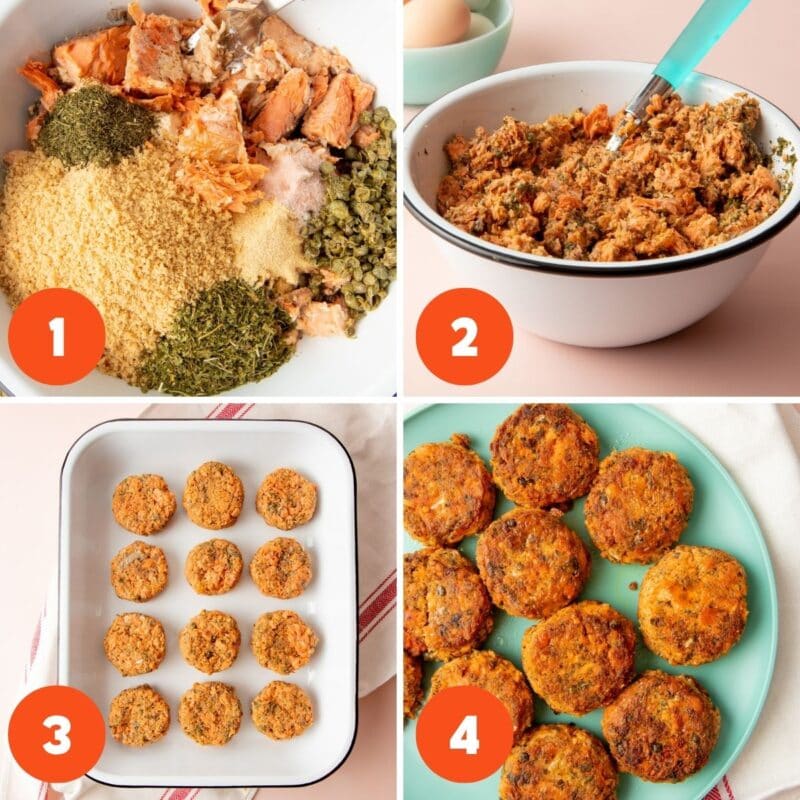
- Combine everything in a large mixing bowl.
- Mix everything together with a fork in a large bowl, making sure not to break up the salmon too much. Let it rest for a few minutes.
- Form the mixture into patties, and pan fry them in a hot skillet in 2-3 batches over medium heat.
- Move the finished salmon patties to a paper towel-lined plate to absorb some of the oil while you cook the rest of the cakes.
Variations and Substitutions
This recipe is super forgiving and customizable, here's how to make some swaps:
- Make it gluten-free: Sure can! Swap out the breadcrumbs for gluten-free panko breadcrumbs.
- Make it paleo/Whole 30: Swap out the breadcrumbs for ⅓ cup blanched almond flour and two tablespoons coconut flour.
- Make it egg-free: Use chia, flax, or gelatin eggs as described in the recipe notes below.
- Make it with fresh or frozen salmon: Roasting the filets (thawed if frozen) until flaky in a 400°F oven-about 7-12 minutes, depending on the thickness of the filets. Then flake the salmon and use just as you would with canned salmon.
- Bake them instead of frying: Bake on a greased or silicone baking mat-lined baking sheet at 375°F for 15-18 minutes, or until golden brown.
- Make tuna patties: For the recipe below, you'll need between 5-6 of the 6-ounce cans of tuna. Everything else in the recipe works as written with tuna.

Want to save this recipe?
Storage and Reheating Tips
Cooked salmon patties will keep in an airtight container in the fridge for 3-5 days. We reheat salmon cake leftovers in the toaster oven or air fryer at 350°F until crisp and heated through (about 3-5 minutes). You can also reheat them in the conventional oven or in a skillet. I would skip the microwave-not only does it make the patties soggy, but it'll also stink up your whole house!
Make Ahead and Freezing Instructions
To make these ahead, I recommend freezing before cooking-just form the patties as the recipe lists, and then freeze in a freezer-safe container with parchment paper to divide layers of patties. You can also flash freeze the patties on a baking sheet lined with parchment paper, then when frozen, transfer the patties to freezer bags. Thaw the frozen patties in the refrigerator, and then cook them in a skillet the same way you would the fresh patties.

Expert Tips and Tricks
- Wild Alaskan red or pink salmon is going to be the best of the best when it comes to canned salmon. We prefer pink salmon in our house because it has a slightly less fishy flavor.
- Salmon patties are great topped with a tartar sauce, remoulade sauce, or tzatziki sauce.
- Canned salmon comes with some small bones in it-no need to take them out. The canning, mixing, and cooking processes breaks the bones down to where they are completely edible (and even a good source of calcium).
- Some folks (AKA: my mom!) use crushed saltines in place of breadcrumbs in this recipe.
- Canned salmon varies in moisture and fat content, so if your patties seem to fall apart, you might need to add more "glue" in the form of eggs. Just add in another egg, plus some extra bread crumbs, until you get a very sticky consistency.
- It's also important to not mess with the salmon cakes once they are in the skillet frying. Place them in the oil, and then don't move them! Let them get a good, solid crust on the outsides before flipping-this will help keep them together. Repeat with the other side.
What To Serve With These
In our house, we love serving our salmon cakes with classic comfort food sides like mac and cheese, sweet potato fries, or potato salad. We always make sure to have something fresh and green on the side, too-a fresh green salad is always a winner in our house!
Love this recipe? Please leave a review and a 5-star rating! This helps other home cooks find this recipe. Appreciate you!
📖 Recipe
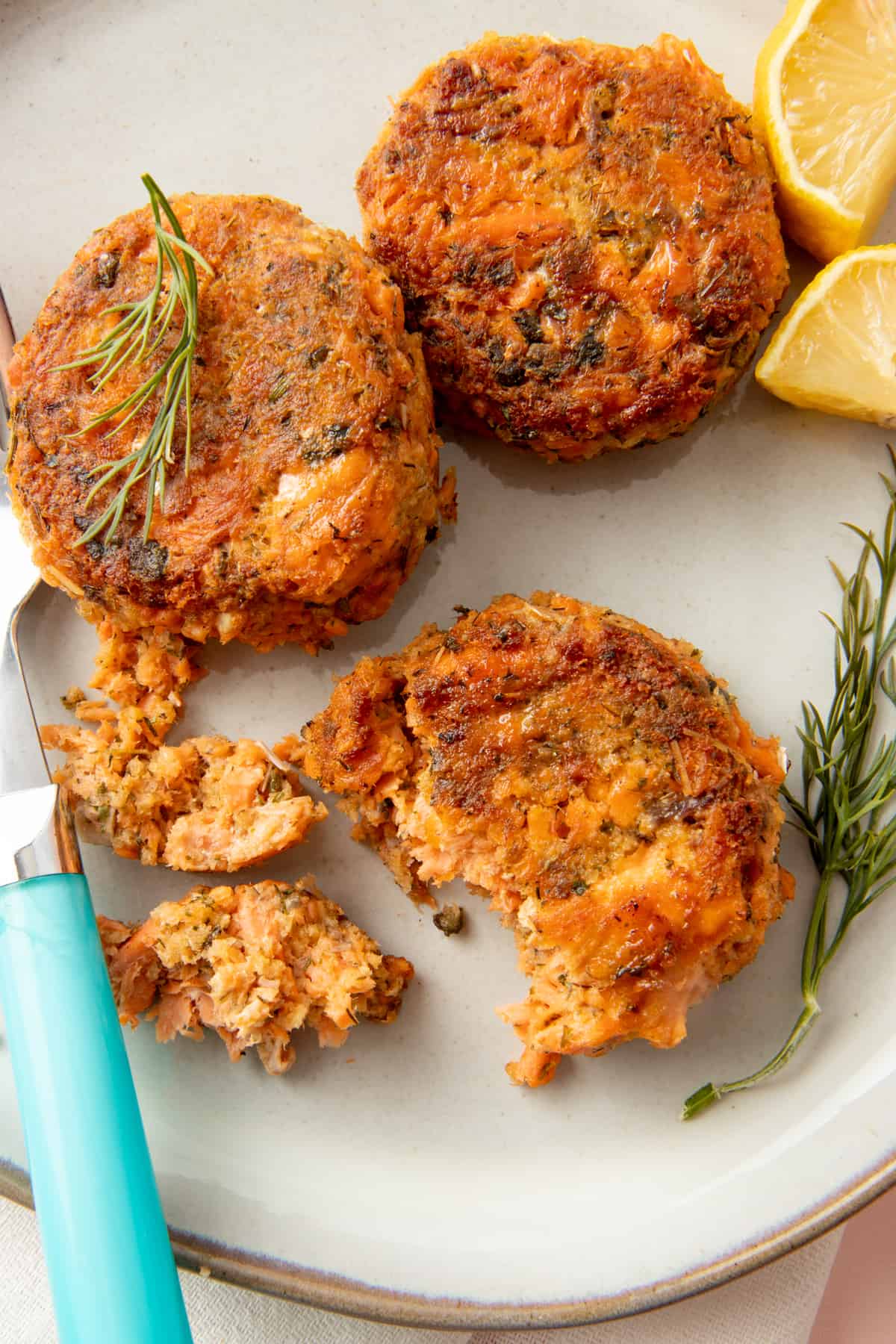
Easy Salmon Patty Recipe
Ingredients
- 2 14.75- ounce cans salmon drained (see notes about using fresh or frozen fillets)
- 2 large eggs gelatin, flax, and chia eggs all work as well, see notes
- ½ cup panko bread crumbs
- ¼ cup minced fresh parsley or 2 tablespoons dried parsley
- 1 tablespoon capers drained and minced, optional
- 1 tablespoon fresh minced dill or 1 teaspoon dried dill
- 1 teaspoon garlic powder
- ½ teaspoon onion powder
- ¼-½ teaspoon salt see notes
- Avocado oil, coconut oil, or other high smoke point oil for cooking
- Fresh dill, lemon wedges, tartar sauce, or remoulade sauce for serving
Instructions
- In a medium-size mixing bowl, combine 2 14.75- ounce cans salmon (drained), 2 large eggs, ½ cup panko bread crumbs, ¼ cup minced fresh parsley or 2 tablespoons dried parsley, 1 tablespoon capers (if using), 1 tablespoon fresh minced dill or 1 teaspoon dried dill, 1 teaspoon garlic powder, ½ teaspoon onion powder, and ¼-½ teaspoon salt. Using a fork, combine the mixture well, but don't break up the salmon too much-you want some good size flakes. Set the mixture aside and allow it to rest for about 5 minutes.
- Meanwhile, preheat a large skillet over medium-high heat. Add enough cooking oil to coat the entire surface with a ¼-½" layer of oil.
- Form the salmon mixture into 12 patties, about 2 ⅓" in diameter by 1" high. Place the patties in the hot skillet, making sure to not overcrowd the pan-depending on your skillet size, you may have to do 2 or 3 batches.
- Pan fry over medium-high heat for 6-7 minutes each, or until the underside is crisp and golden brown. Do not move the salmon cakes while they are cooking, or they may crumble apart. Gently flip, and fry for another 4-5 minutes or until the other side is crisp and golden brown. Transfer to a paper towel-lined plate to drain, and repeat with remaining formed patties.
- Serve topped with tartar sauce or remoulade sauce, plus fresh lemon wedges and fresh dill, if desired.
Video
Notes
- If you choose to use capers (which add a wonderful briny flavor), use less salt-¼ teaspoon. If you leave the capers out, use ½ teaspoon salt. Also keep in mind that the sodium content of canned salmon can vary widely. If working with a new brand, you might want to mix up the cakes using ¼ teaspoon of salt, fry up a small meatball of the mixture to taste test, and then adjust the salt from there.
- We do not recommend making this in the food processor. This quickly turns the salmon into paste-which makes for less-than-appetizing salmon cakes.
- You can sub in fresh minced onion and garlic for the powders; however, you'll need to saute the fresh vegetables before adding them to the mixture-the salmon cakes do not cook long enough on their own to soften fresh vegetables.
- Canned salmon comes with some small bones in it-no need to take them out. The canning, mixing, and cooking processes breaks the bones down to where they are completely edible (and even a good source of calcium).
- You can make this recipe using fresh or thawed frozen salmon filets by first roasting the filets until flaky in a 400°F oven-about 7-12 minutes, depending on the thickness of the filets. Then flake the salmon and use just as you would with canned salmon. Fresh and frozen salmon contain no sodium, so use ½ teaspoon of salt in your salmon cakes mixture.
- This recipe works well with gelatin, flax, and chia eggs. To make two flax or chia eggs, combine 2 tablespoon chia seeds or ground flax seeds with 6 tablespoons of warm water-let sit for 5 minutes, or until thick and gelled. To make two gelatin eggs, combine 2 tablespoons of unflavored gelatin powder with 2 tablespoons cool (room temp is fine) water. Let sit for a minute or two to bloom. Then stir in 4 tablespoons of boiling water vigorously until the gelatin is dissolved. Let the mixture sit for 1-2 minutes to thicken and gel.
- You can make these salmon cakes paleo and Whole30-friendly by using ⅓ cup blanched almond flour and 2 tablespoons coconut flour in place of breadcrumbs.
- Yes, you can bake these salmon cakes. Bake on a greased or silicone baking mat-lined baking sheet at 375°F for 15-18 minutes, or until golden brown. They won't be quite as crispy as the fried version, but they'll still be delicious.
- This recipe also works beautifully with canned tuna!


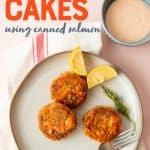
Delicious!!! I used chia seeds since eggs are so expensive right now but I will do it from now on because of the fiber, not having to wash my hands after forming the patties, and not having to worry about the patties cooking all the way through. I had them with asparagus and hollandaise sauce and it was sooo good dipped in the sauce. Thanks for the recipe 🙂
You're so welcome! Thanks so much for coming back to tell us about your experience. We really appreciate it!
I just made these and ate one. baked in the oven. GF crumbs. I had 6oz cans of salmon so I did 4, sauted onions, I would even double the capers I think. or maybe i'll put some in the dipping sauce. They stayed pretty much together but a lot of huge cracks on top, maybe how they were put together. Will make again!
I made these with one 150g can of salmon, an egg, 4tbsp of breadcrumbs and a few spices. It turned out AMAZING! I loved it and will definitely make it again. Though in the future I’d double the ingredients and make 3 Patties, as it was very thick. Lovely recipie.
If I'm using frozen filets, how many filets/total ounces would I need for this recipe?
Hi, Tim! There usually isn't too much water to drain off from the canned salmon, so you're looking for around the same number of ounces. Anywhere in the 28 to 30 ounce range should work! We recommend you cook and flake the salmon before using it in this recipe. Since canned salmon adds a good bit of moisture, the patties tend to hold together fairly well before cooking. If the patties you make with the cooked salmon seem crumbly and don't hold together as well, you might need to add more egg and breadcrumbs to compensate. Let us know how they turn out for you!
This looks delicious! The baking instructions say "15-28 minutes" -- that seems like a long range! Does it tend towards one side or the other?
Whoops! That was supposed to be 15-18. Thanks for the catch!
easy, yes, easy is great during the weekdays or really any time as far as I'm concerned, but I've run out of easy recipes, or I've run them into a rut, so I really appreciate new ones, so thank you!